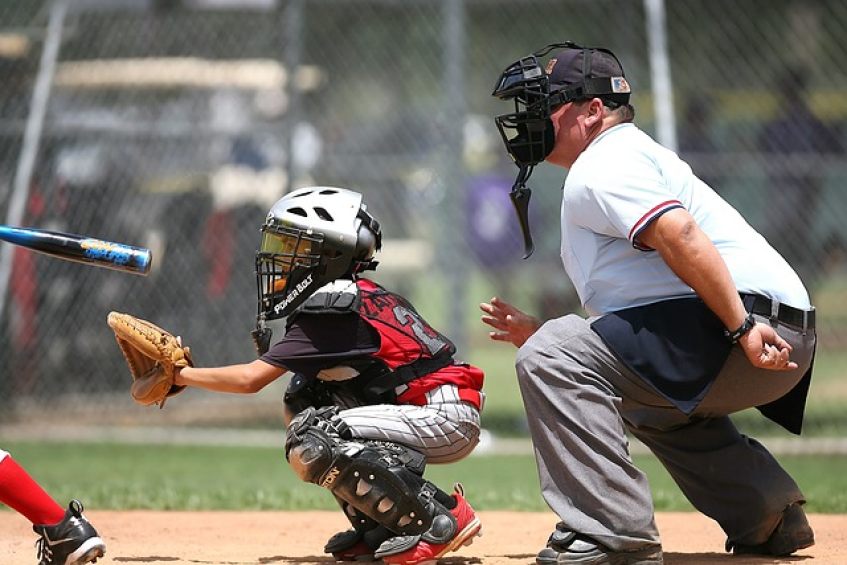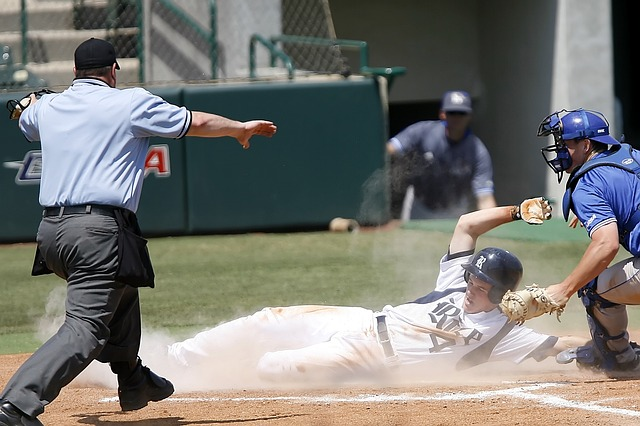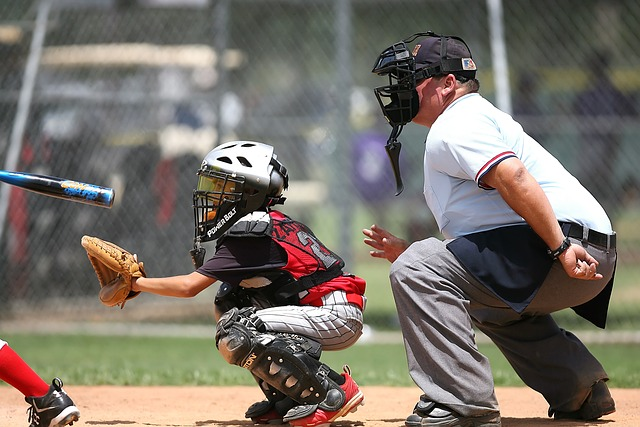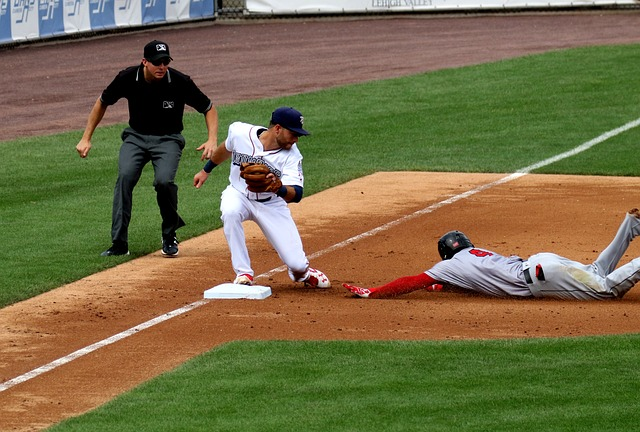
Hello, fellow baseball enthusiasts! Have you ever found yourself wondering about the "blue" folks out there on the diamond? No, I'm not talking about players from the LA Dodgers or the Toronto Blue Jays. I'm talking about the guys who control the game, the ones making the tough calls - the umpires.
In the grand old game of baseball, we refer to our umpires as "blue", and if you're new to this, you might be scratching your head wondering why. Well, today is your lucky day because we're diving deep into the world of umpires. We'll explore why they're dubbed as "blue", and we'll delve into the vital role they play in every Major League Baseball (MLB) game.
Now, you might think that the job of an umpire is straightforward - you know, just stand there, watch the game, and make a call. But I assure you, there's so much more to it. The umpires, or "blues" as they are endearingly called, are a quintessential part of our beloved sport. They ensure fairness, uphold the rules, and keep the spirit of the game alive. From the home plate umpire to the third base umpire, each has a crucial role in maintaining the integrity of the game.
So whether you're a newbie to baseball or a seasoned fan wanting to learn more, stick around. We're going on a journey to discover why Major League umpires wear that badge of 'blue' honor and how they make the magic of baseball come alive.
Remember, this isn't just about 'why are umpires called blue?' This is about the essence of baseball, about understanding and appreciating the game we all love so much. So, put on your favorite team's cap, sit back, and join me as we head into the fascinating world of baseball umpires.
Stay tuned, because we're just getting started. In the coming sections, we'll dive into the various roles of an umpire, the origin of the term 'blue', the meaning behind their uniforms, and much more. Let's play ball!

You've probably heard the saying, "the devil is in the details," right? Well, in baseball, the details lie in the hands of the "blues." These folks, also known as umpires, are the custodians of the game. But what exactly does an umpire do in baseball? Let's find out.
Imagine you're at a Major League Baseball game. The crowd is roaring, the hot dogs are sizzling, and the energy is palpable. But amidst all this chaos, there's a group of four individuals who are the epitome of calm. They are the four umpires who are tasked with the critical job of officiating the game.
The umpiring crew is typically composed of the home plate umpire, the first base umpire, the second base umpire, and the third base umpire. Let's break down their roles one by one.
The home plate umpire is arguably the most crucial umpire in a baseball game. They make pivotal decisions, including calling balls and strikes, fair and foul balls, and plays at the plate. You can think of the home plate umpire as the conductor of the orchestra, leading the symphony that is a baseball game.
Then, we have the base umpires, namely the first base umpire, the second base umpire, and the third base umpire. These umpires focus primarily on calls related to their respective bases - safe or out decisions, checking for balks, and judging whether runners left their bases too early on fly balls.
The first base umpire, apart from their base-specific duties, also assists the home plate umpire in observing whether batted balls are fair or foul, and they might also make judgment calls on check swings.
The third base umpire, also known as the 'hot corner' umpire, makes calls on plays at third base. They also assist the home plate umpire with fair or foul calls on batted balls and are responsible for plays involving the runner going from second to third base.
It's important to note that these roles aren't set in stone. The umpiring crew rotates their positions every game, ensuring that each umpire gets a taste of every angle of the game. This rotation system is a testament to the versatility and adaptability demanded of MLB umpires.
But what about the difference between a referee and an umpire in baseball? Well, in most sports, referees observe the game and make decisions from a distance, while umpires are embedded in the action, making decisions in close proximity to the players. In baseball, we call them umpires, signifying their crucial involvement in the game's proceedings.
The umpire's judgment is of paramount importance in baseball. They have the final say, their decisions are rarely overturned, and they have the power to eject players, coaches, or managers who argue excessively. The integrity of baseball rests on their shoulders.

Now that we understand the pivotal role umpires play in baseball let's delve into the reason behind their unique moniker - "Blue." The question "why are umpires called blue?" has an interesting history, one that is deeply rooted in the tradition and evolution of the game.
Back in the early days of professional baseball, umpires didn't have the standardized uniforms we see today. In fact, they used to wear suit coats, ties, and straw hats—quite the fashion statement, wouldn't you agree? However, as the game evolved and became more formalized, so too did the attire of the umpires.
The transition to the blue uniform occurred in the 19th century. Major League Baseball decided to adopt a standard uniform for its umpires to lend an air of authority and professionalism to the role. The color of choice? Blue. This led to the nickname "Blue" for the umpires.
But why blue, you ask? Blue is often associated with stability, trust, and wisdom - qualities that are absolutely essential for an umpire. By wearing blue, umpires symbolize their commitment to upholding the integrity of the game.
Today, the color of the uniform may vary. You might see Major League umpires wearing black or even light grey. But regardless of the color they wear on a particular day, the nickname "Blue" has stuck. It's a term of endearment, a nod to the history and tradition of the game, and a reminder of the critical role umpires play in every baseball game.
To answer the questions, "Is calling an umpire blue an insult?" and "Do umpires like to be called blue?" - No, calling an umpire "Blue" is not an insult, and yes, most umpires have embraced the nickname. It's part of the rich tapestry of baseball language and tradition.
So, the next time you're at a baseball game, remember the history behind the umpires' nickname. When you see the home plate umpire making a crucial call or the third base umpire ruling on a close play, remember that they're not just "Blue" because of the color of their uniform. They're "Blue" because they embody the wisdom, stability, and trust that the color represents.

Becoming an umpire is no small feat. It's a rigorous process that requires dedication, a deep understanding of the game, and exceptional decision-making skills. So, let's explore the path that many Major League umpires have trodden to get where they are today.
The journey begins in the world of amateur umpiring, often at the local leagues or youth baseball games. Here, the amateur umpire gets a taste of the responsibility that comes with the role. They learn to make tough calls, handle disputed plays, and ensure the game is conducted within the rules.
Once they've gained some experience, these amateur umpires may decide to take the next step towards becoming a professional. This is where umpire schools come in. There are a few professional umpire schools sanctioned by Major League Baseball, where aspiring umpires learn the ins and outs of the profession.
Umpire school is a demanding experience. Aspiring umpires delve deep into the rulebook, engage in practical training exercises, and learn about game management. They also begin to understand the subtleties of different umpiring positions – from the home plate umpire who makes crucial ball and strike calls, to the base umpires who judge whether runners are safe or out.
After umpire school, the best of the best are selected to attend an advanced course. From there, the top umpiring prospects are assigned to work in the minor leagues. This is where they truly start their professional career, honing their skills and gaining valuable on-field experience.
Starting in the rookie league, these professional umpires begin working their way up the ranks of the minor leagues, from Class A to Double-A, and finally to Triple-A - the last step before reaching the Majors. It's a journey that requires patience, resilience, and a relentless pursuit of excellence.
A note on terminology: while we often refer to them as "referees" in other sports, in baseball, the officials are always called "umpires." Whether it's a home plate umpire, a first base umpire, or an outfield umpire, each one plays a crucial role in ensuring the fairness and integrity of the game.

Now that we've learned about the journey to becoming an umpire, let's delve into the specifics of what these Major League umpires do in a baseball game.
In a standard Major League Baseball game, you'll find four umpires. Each one has a distinct role, and together, they form the umpiring crew. The crew chief, often the most experienced umpire, leads the group and has additional responsibilities such as handling official reviews.
The home plate umpire has perhaps the most visible role. Positioned behind the catcher, the home plate umpire makes critical calls on balls, strikes, and plays at the plate. This umpire also declares foul balls and is the primary authority on interpreting the rules of the game. But that's not all. The home plate umpire signals the start and end of each game and is responsible for maintaining the pace of play.
Next, we have the base umpires, often referred to as the first base umpire, second base umpire, and third base umpire. They judge whether runners are safe or out at their respective bases, and they also make calls on batted balls, ruling if they're fair or foul.
In certain situations, Major League Baseball deploys six umpires. In these cases, two additional umpires, known as the outfield umpires or right field and left field umpires, are added. They are primarily responsible for judging whether balls are fair or foul and if they pass over the outfield fence in fair territory.
Remember, the umpiring crew rotates their positions every game, giving each umpire the opportunity to serve in different roles. This ensures a balanced understanding and application of rules across the board.
While their jobs are demanding, umpires are well compensated. The salary of a Major League Baseball umpire varies based on experience and tenure, but suffice to say, it's a rewarding career for those who love the game of baseball.

As we delve deeper into the world of Major League Baseball umpiring, we find a rich history filled with unique individuals who have left their mark on the game. These noteworthy umpires have not only excelled in their profession but also contributed significantly to the sport's evolution.
Let's start with Bill Klem, often considered the father of modern baseball umpiring. Klem spent an incredible 37 seasons in Major League Baseball and was known for his authoritative control of games. His dedication to the role of a plate umpire, in particular, was unmatched. He famously said, "It ain't nothin' till I call it," which perfectly encapsulates the umpire's judgment's importance in baseball.
Then we have Doug Harvey, one of the few umpires inducted into the Baseball Hall of Fame. Known as "God" among players, Harvey was respected for his excellent judgment and fair application of the rules during his 31-season career as a Major League umpire. His umpiring style influenced many major league umpires, encouraging them to prioritize consistency and fairness.
Another trailblazer in umpiring is Pam Postema, who came close to becoming the first female umpire in Major League Baseball. She umpired in the minor leagues for 13 seasons and reached the class AAA level, the highest level before the major leagues. While she didn't make it to the Major League level, her professional career paved the way for more women in professional umpiring.
Last, but certainly not least, let's talk about Bruce Froemming, who holds the record for the most games umpired in Major League history. With a career spanning an impressive 37 seasons, Froemming's commitment to the game is truly inspirational.
These individuals, along with many other noteworthy umpires, have shaped the way the game is officiated. Their hard work, dedication, and love for baseball have set the standard for future generations of umpires in Major League Baseball.

Being an umpire in Major League Baseball is a prestigious position that comes with significant responsibility. But what does the life of an umpire really look like? Let's delve into the daily grind, challenges, and rewards of this critical role in the world of baseball.
A professional umpire's journey usually begins at one of the professional umpire schools accredited by Major League Baseball. After graduating, the top umpiring prospects are selected to attend an advanced course, which serves as a gateway to professional baseball. From there, they start their professional career in the minor leagues.
Just like players, umpires have to work their way up the ranks. They start in the rookie league and progress through single-A, double-A, and triple-A levels. Each level presents more complex situations, faster play, and higher stakes, requiring the umpire to constantly hone their skills and judgment.
An umpire's progression is not just about time served - it's about demonstrating excellence at every turn. The most experienced umpire, often called the crew chief, takes on additional responsibilities, such as handling administrative duties and serving as the main point of contact with the league office.
Once they reach the major league level, the life of an umpire is a mix of intense focus, constant travel, and irregular hours. During the season, MLB umpires often work a game almost every day, with very few days off. They spend a lot of time on the road, moving from one city to another.
Despite the challenges, being a Major League Baseball umpire comes with unique rewards. There's the thrill of being on the field with some of the world's best athletes, the satisfaction of upholding the integrity of the game, and the camaraderie among the umpiring crew. And let's not forget the love of the game - because at the heart of every umpire's career is a deep passion for baseball.
No, it isn't an insult. The term "Blue" is a traditional nickname for umpires in baseball, and it's derived from the blue uniforms that umpires traditionally wore.
It depends on the individual umpire. While some may see it as a term of respect harking back to their profession's history, others might prefer to be addressed more formally.
The umpire's role is to enforce the rules of baseball. This includes making judgment calls on plays, ensuring the game is played fairly, and maintaining order on the field. The home plate umpire, in particular, has the responsibility of calling balls and strikes, while the base umpires are responsible for making calls on the bases and in the outfield.
Umpiring is a demanding job that requires extensive knowledge of the rules, excellent judgment, and the ability to make split-second decisions under pressure. Aspiring umpires must attend umpire schools and work their way up through the minor leagues before they have a chance of umpiring in Major League Baseball.
The salary of a Major League Baseball umpire varies based on experience and tenure, but it can range from $120,000 for a rookie umpire to $350,000 for a veteran with many years of service. Minor league umpires are generally paid between $2,000 to $3,500 per month during the season. However, their salary can vary depending on their experience and the level of the minor league in which they officiate.
In Major League Baseball, there are typically four umpires in a game, one for each base and the home plate. However, during playoff games, two additional outfield umpires are added.
The third base umpire, crucially positioned in a baseball game, shoulders multiple responsibilities. They determine if a batted ball passing third base is fair or foul, significantly influencing the game's course. They also adjudicate whether a runner is safe or out during a play at third base and rule if a ball hit to their side of the outfield was fairly caught or trapped. In many stadiums, they judge if a hit to the outfield qualifies as a home run. They monitor baserunners for premature departures from their base during a tag-up play from a caught fly ball. Like all umpires, they can call time out, eject players or coaches, and enforce the game's rules. It's important to note that Major League umpires rotate their positions within a series, ensuring the third base umpire is well-versed in all game aspects.
Remember, these are just a few of the many questions that can come up when learning about umpires in baseball. The role of an umpire is vital to the game, and understanding it can deepen your appreciation for the sport.
In the world of Major League Baseball, umpires play a pivotal role, ensuring the integrity of the game and enforcing the rules. Their journey is not an easy one, with a rigorous path through umpire school and the minor leagues before they even get a chance to step onto a Major League field. They're known as "Blue," a nickname that harks back to the old uniforms they used to wear. These professionals work tirelessly, often under intense scrutiny, to make the correct calls and keep the game fair and enjoyable for everyone involved.
From their positions on the field - the plate umpire, first base umpire, second base umpire, and third base umpire - they have a unique view of the action. And while they might sometimes be the bearers of bad news for some players and fans, their work is indispensable to Major League Baseball. So, the next time you watch a baseball game, spare a thought for the umpires, the unsung heroes of the sport we love.
Chris Sloan is a former baseball league commissioner and travel baseball coach who has made significant contributions to the sport. In 2018, he founded selectbaseballteams.com, a website that helps parents find youth and travel baseball teams in their local areas. Since its launch, the website has experienced impressive growth, offering a wealth of resources including teams, news, tournaments, and organizations. Chris's unwavering passion for baseball and his innovative approach to connecting parents with quality baseball programs have earned him a respected reputation in the baseball community, solidifying his legacy as a leading figure in the world of youth and travel baseball.
There are 0 comments on "Why are Umpires Called Blue? - Plus other Umpire Facts"
chandler allen says:
"Hi my name is chandler, i’ve enjoyed..."
On Wanting to tryout for summer ball. as an 18 year old
david graham says:
"With no current MLB team in Canada,..."
On With no current MLB team in
Charles Chavez says:
"To All Coaches: Do you have13U or..."
On Looking for Games